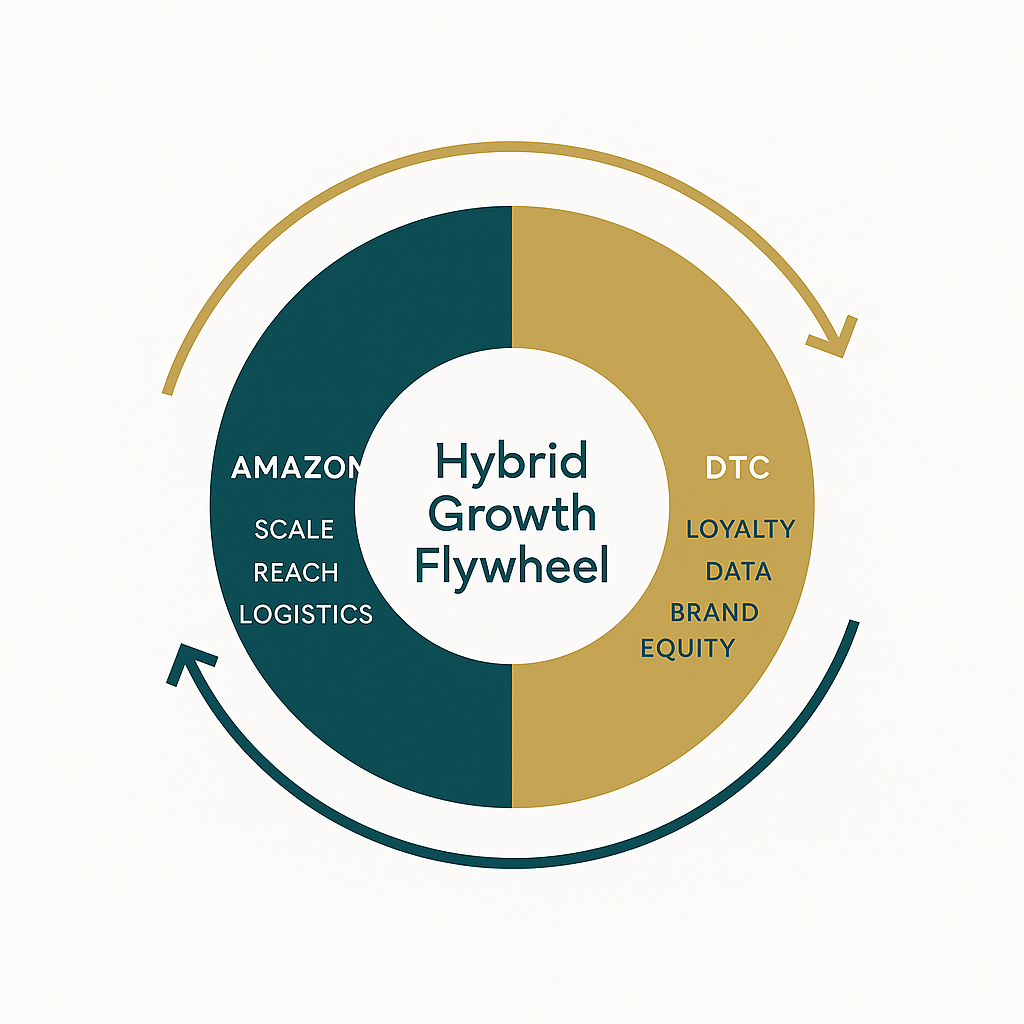Picture this: a bold, emerging F&B brand, one signature hero product, ready to disrupt the market. The founders know they’ve hit the right note, but growth whispers.
For consumer packaged goods (CPG) founders, the big question is no longer “Should I sell on Amazon or build my own direct-to-consumer (DTC) site?” The real question is: how do you orchestrate both to fuel sustainable growth?
Amazon delivers scale and speed; DTC builds loyalty and brand equity. Brands that learn to blend the two create resilient revenue streams, stronger customer relationships, and long-term velocity. In this post, we’ll explore why a hybrid Amazon + DTC strategy is becoming essential, how to build one, and what risks to avoid.

Why Hybrid Matters Now
Amazon = Reach and Scale
Amazon controls nearly 40% of U.S. e-commerce sales (Insider Intelligence). For new CPG entrants, it offers:
- Built-in buyer trust
- Massive search traffic and intent
- Fulfillment and logistics via FBA
- Immediate category visibility
DTC = Control and Loyalty
A brand’s own site gives:
- First-party data (emails, purchase histories, behavioral insights)
- Higher margins without marketplace fees
- Creative control over content and storytelling
- Long-term loyalty through subscriptions and community
Together = Resilience
Relying on one channel is risky. Policy changes, rising ad costs, or fulfillment disruptions can derail growth. A hybrid framework diversifies revenue and builds a stronger foundation.
The Four Pillars of a Hybrid Framework
1. Optimize Amazon for Discovery
Amazon is your acquisition engine. To maximize it:
- Listing SEO: Optimize titles, bullets, and backend keywords for high-intent searches.
- Enhanced Content: Use A+ content and Brand Stores to showcase your story.
- Advertising: Layer sponsored product, sponsored brand, and DSP campaigns.
- Social Proof: Build early reviews, then amplify them with inserts and follow-up strategies.
Deep dive: Admetrics – Amazon Marketing Strategy
2. Build Your DTC as the Brand Home
Your site is more than a checkout page. It’s the anchor for your identity.
- Data capture: Use email and SMS signup flows to build owned audiences.
- Exclusive SKUs: Offer bundles, subscription products, or premium lines unavailable on Amazon.
- Content and storytelling: Elevate your brand narrative beyond Amazon’s constraints.
- Community building: Loyalty programs, referral incentives, and brand clubs.
Insight: Blue Wheel Media – Amazon + DTC Synergy
3. Leverage Cross-Channel Tools
- Amazon Attribution & AMC: See how external ads (Meta, Google) contribute to Amazon sales.
- Buy with Prime: Enable Amazon shoppers to use their Prime benefits on your DTC site, boosting conversion.
- Integrated reporting: Align ROAS across channels to optimize media spend dynamically.
This ensures you’re not flying blind when shifting budget between platforms.
4. Orchestrate Product and Pricing
Channel conflict can erode trust.
- Product differentiation: Launch core SKUs on Amazon; keep premium bundles exclusive to DTC.
- Aligned pricing: Prevent undercutting between channels.
- Innovation pipeline: Test new flavors or packaging via DTC before scaling on Amazon.
This protects margins while expanding choice.

Challenges to Anticipate
Even with a solid framework, hybrid strategies introduce complexity.
- Data Gaps: Without attribution, you may misallocate ad spend.
- Cannibalization: Customers flock to whichever channel is cheaper or easier.
- Operational Complexity: Running FBA and your own fulfillment can strain inventory planning.
- Policy Compliance: Amazon penalizes brands that push shoppers too aggressively off-platform.
- Scaling Costs: DTC acquisition costs can spike before loyalty offsets them.
Practical Tips for Emerging CPG Founders
- Budget for both: Start with a split (e.g., 70% Amazon / 30% DTC), then rebalance quarterly.
- Invest in CRO: On both Amazon and your site, conversion rate optimization pays dividends. (My Amazon Guy CRO metrics)
- Focus on reviews: Nothing drives Amazon sales like credibility.
- Prioritize retention: On DTC, build repeat order flows early (email, SMS, loyalty).
- Avoid silos: Amazon, growth marketing, and retail teams should share metrics and learnings.
Conclusion
For emerging CPG brands, growth doesn’t come from choosing between Amazon or DTC, it comes from building a hybrid framework where each channel strengthens the other.
- Amazon accelerates discovery.
- DTC deepens loyalty.
- Together, they provide resilience, data insights, and compounding growth.
Brands that master this balance stand out in crowded categories and expand with confidence.
Is Your Brand Set Up for Hybrid Growth?
Curious about how this framework could fit your brand? Explore our case studies or reach out for a growth assessment. Yventure helps emerging brands design channel strategies that unlock scale while preserving identity.



